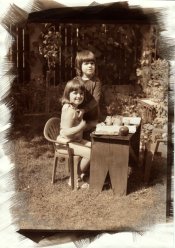I can get good d-max with a single coating if I use a glass rod. However, I tend to prefer the brush method, in which case I double coat for better d-max.
I find I can get perfectly consistent results as long as the following are always the same:
- time between the applications of the first and the second coating (I usually wait for half an hour)
- time between the application of the second coating and the exposure (I usually wait for an hour)
- concentration of the clearing bath
- clearing time
- concentration of the fixing bath
- fixing time
- toner concentration
- toning time
Do not wash the print after exposure in tap water! Tap water is often slightly basic, and basic environments convert the iron salts and form iron hydroxides, which have low solubility. This can make complete clearing impossible. That's why the first washing baths should be slightly acidic. Tap water is fine after the print has cleared completely.
Some acids are better than others. Citric acid is a strong chelating agent for iron and helps with its removal from the paper's fibers. Acetic acid isn't.
After exposure I wash the print in two 1% citric acid baths for three minutes each. No problem with clearing even with double coatings.
Don't use full strength fixer, and don't use rapid fixer. Just a 2-5% plain sodium thiosulfate solution will do. Anything stronger will bleach the highlights.
If you plan to tone in selenium, use a very high dilution. I dilute it 1+200, which gives me enough time to assess its progress and to stop the toning when the desired tone has been reached. If it's too concentrated, then not only will it partially bleach the image, but it will go to completion in no time, and completion means an ugly yellowish orange.
The print darkens considerably while drying. If it looks great wet, it's guaranteed to be too dark when dry. Try to aim for a slightly lighter than normal print.
When you mix the sensitizer, use a syringe to add the silver nitrate solution to the mix very slowly, just a couple of drops at a time, while stirring vigorously. Otherwise it will precipitate and will never dissolve again. Once mixed the sensitizer has good keeping properties. Mine is a little over a year old and is still going strong. I'll finish it off before it dies of old age.
Here's one of my latest vandyke prints. Double coating by brush, cleared in 1% citric acid for six minutes (two baths of three minutes each), fixed in 2% sodium thiosulfate for five minutes, toned in selenium 1+200 for three minutes, hypo-cleared in 2% sodium sulfite for five minutes. The paper is Fabriano Academia. 8x10" Kodak TXP developed in ABC.







